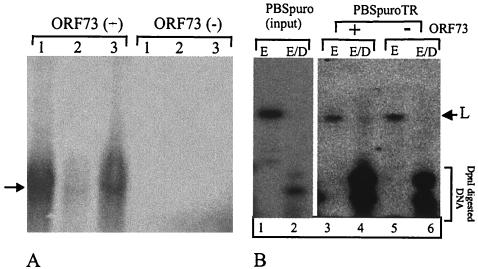FIG. 10.
HVS C488 ORF73 is essential for episome maintenance and DNA replication. (A) HVS cosmid Cos331 was used to transfect HEK293 cells with or without ORF73 expression vectors. Transfected cells were selected in the presence of G418 for 3 weeks. Clones generated after G418 selection were passaged seven times, and three clones from each set were analyzed for the presence of episomal DNA as described by Gardella et al. (26). Episomal DNA migrated into the gel and was detected with a 32P-labeled cosmid probe. Clones expressing ORF73 showed the presence of cosmid DNA (arrow), but cells lacking the expression of ORF73 did not show detectable amounts of cosmid DNA. (B) Replication of TR-containing plasmids in ORF73-expressing cells. HVS C488 TRs were excised from Cos331 with TaqI and ligated into pBSpuro at the ClaI restriction endonuclease site. The resulting plasmid was used to transfect HEK293 cells, with selection in the presence of puromycin for 96 h. Low-molecular-weight DNA extracted by a modified Hirt procedure (32) was digested with either EcoRI (which cuts only once in the plasmid backbone) (E) or EcoRI and DpnI (E/D). Digested products were resolved on an 0.8% agarose gel and analyzed by Southern hybridization with a 32P-labeled pBSpuro backbone probe. Lanes 1 and 2 show the digestion of input plasmid pBSpuro. The absence of a DpnI-resistant band in lane 2 indicates the complete digestion of DNA (lighter exposure than that in other lanes). The presence of a DpnI-resistant band in lane 4 suggests the replication of DNA containing HVS TRs in ORF73-expressing cells (L). In contrast, cells lacking ORF73 expression did not show a detectable DpnI-resistant band (lane 6), suggesting that ORF73 is important for DNA replication.

